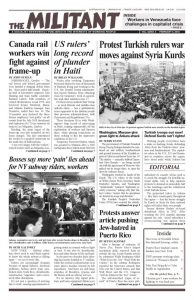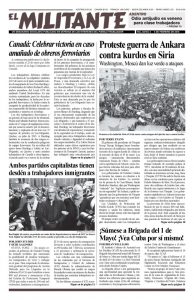Below is an excerpt from The First and Second Declarations of Havana. Its Spanish-language edition is one of Pathfinder’s Books of the Month for January. The excerpt is from the preface, written by Mary-Alice Waters, a leader of the Socialist Workers Party and president of Pathfinder Press. The declarations — manifestos of revolutionary struggle — were adopted by million-strong assemblies of Cuban workers, farmers and youth in 1960 and 1962. Copyright © 2007 by Pathfinder Press. Reprinted by permission.
BY MARY-ALICE WATERS
“Politics begin where millions of men and women are; where there are not thousands, but millions. That is where serious politics begin,” Lenin reminded delegates to the 1918 congress of the Russian Communist Party (Bolshevik) a few months after the triumph of the October Revolution. That is the power that speaks through the First and Second Declarations of Havana, the power evident in the photos included here of those immense concentrations of confident, joyous, and determined toilers in the midst of deciding their own future.
The year and a half between the First and Second Declarations was marked above all by the “serious politics” of millions.
- Cuban prime minister Fidel Castro’s September 1960 presentation of “The Case of Cuba” before the General Assembly of the United Nations, which he ended by citing the closing portions of the First Declaration of Havana summarizing what the Cuban Revolution stands for;
- the mobilizations across the island accompanying the revolutionary government’s Urban Reform Law nationalizing housing, slashing rents to 10 percent of a family’s income, and thus putting an end, in the words of the Second Declaration of Havana, to “the abusive system that turned housing into a means of exploiting people”;
- Washington’s decision to break diplomatic relations with Havana;
- the mobilization of 100,000 young people to the furthest reaches of the countryside and working-class barrios in the massive, successful campaign that wiped out illiteracy in Cuba in less than a year (establishing the model for the hundreds of thousands of Cuban volunteer teachers and medical personnel who in coming decades would put their training to use among those oppressed by imperialism the world over);
- the U.S.-organized and -financed invasion of Cuba at the Bay of Pigs in April 1961, which ended less than seventy-two hours later in ignominious defeat with the surrender of the invading mercenaries;
- the beginning of the first “Freedom Rides” across the U.S. South to challenge Jim Crow segregation in interstate public transportation;
- Che Guevara’s denunciation at Punta del Este, Uruguay, in August 1961 of the fraud of the U.S. government’s newly launched Latin American “Alliance for Progress”;
- Cuba’s first internationalist aid to Africa, sending arms and ammunition to Algeria’s National Liberation Front (FLN) fighting French colonial rule and providing treatment to wounded combatants as well as housing and education to orphans of the war;
- the imposition of a total trade embargo against Cuba by the U.S. government on February 3, 1962.
What was the Cuban people’s response to the announcement that foreign ministers of the Organization of American States would meet in Punta del Este in late January 1962 to consider collective measures to counter “the threat to the peace and political independence of the American states” arising from intervention by “extra-continental powers”?
“Now that they’re preparing the stage to carry out the puppets’ farce,” Fidel announced to a mass rally on January 2 celebrating the third anniversary of the victory over the tyranny, “let’s mobilize!” …
On February 4 over a million people answered that call to arms, effectively repudiating the resolutions adopted four days earlier by what they referred to as the “Yankee ministry of colonies.” …
[T]he declaration effectively explained to the vanguard of workers, farmers, and revolutionary-minded youth increasingly engaged in struggles throughout the Americas, including the United States, why the possibilities of success were in their hands and none others.
• It explained why the national bourgeoisie is incapable of leading a struggle against imperialist domination “even when its interests are in contradiction to those of Yankee imperialism … for the national bourgeoisie is paralyzed by fear of social revolution and frightened by the cry of the exploited masses.”
- It explained why no revolution could succeed unless the working class was capable of leading the struggle in the countryside as well, forging and continuously working to maintain a powerful alliance in struggle with the peasantry, with the oppressed indigenous peoples of the Americas, with the Blacks, the Chinese, and the other superexploited sections of the population. Over and over, it pointed to the importance of the unfolding mass struggles by Blacks to bring down the system of Jim Crow segregation in the United States.
- It explained how unity in action of the toilers against imperialism and its agents, without which no revolutionary victory is possible, could be achieved only if sectarianism, dogmatism, and the deliberate fostering of division as opposed to common struggle could be eradicated.
- It explained the “bloody drama” Washington and its puppets were preparing for Latin America — one that soon became all too real — as the great masses of the continent began to rise in struggle, and the fatal illusion of believing in the possibility under such conditions of “wresting power by legal means, means that do not and will not exist, from the hands of ruling classes that are entrenched in all the state positions,” a power they “will defend by blood and fire and with the might of their police and armies.”
- And it pointed to the revolutionary victory at Playa Girón — Washington’s first military defeat in the Americas — as the example that the Cuban people gave to the world “that revolution is possible.”

